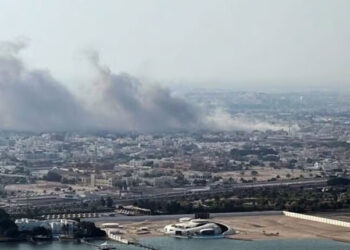Overview of the Escalation
In a significant escalation of the already volatile conflict between Israel and Iran, the Israeli military has launched another round of attacks targeting the Fordow nuclear facility located near Tehran. According to Iran’s semi-official Tasnim News Agency, the strike was carried out by the Israeli army, marking a renewed offensive in an increasingly dangerous standoff. The airstrikes have intensified regional fears of a broader conflict involving multiple state actors, as tensions between Iran and Israel have been escalating over recent weeks.
Details of the Latest Israeli Strikes
Israeli forces reportedly carried out coordinated airstrikes on at least six airports across western, eastern, and central Iran. The targets included both military and dual-use infrastructure. Notably, one of the key targets was the Fordow nuclear facility, which had already been struck by a U.S. attack earlier. The Crisis Management Authority of Qom province confirmed the renewed attack on Fordow, although it did not provide specifics on the extent of the damage.
In addition to the Fordow strike, Israel also reportedly bombed a university in Tehran. While the exact motive behind targeting the university remains unclear, it is speculated that the institution may have had connections with Iran’s nuclear research or military advisory programs.
Destruction of Power Infrastructure
The airstrikes also affected civilian infrastructure. In northern Tehran’s Evin area, a power supply feeder was targeted, causing minor disruptions. However, Iranian authorities assured that there were no widespread power outages and that the damage was contained. This assault on infrastructure, although limited in scale, is seen as part of a psychological warfare tactic aimed at undermining civilian morale.
Israeli Military Claims and Impact on Iranian Air Force
According to a statement released via social media platform ‘X’ by Israeli defense officials, the Israeli military destroyed 15 Iranian aircraft and helicopters through the use of remote-controlled drones. These included vital aircraft models such as the F-14, F-5, and AH-1, as well as a critical refueling aircraft.
The statement further claimed that the attacks damaged multiple runways, underground bunkers, and airbases, significantly impairing the operational capabilities of Iran’s air force. Military analysts have noted that such strikes aim to weaken Iran’s air defense and deterrence capabilities in the short term.
Iran’s Response: Downing of Israeli Drone
In a counter-operation, Iranian forces successfully shot down a modern Israeli Hermes 900 drone over the city of Khorramabad in Lorestan province. According to local media outlets and the Telegram channel Lorestan News, the drone was intercepted by the Islamic Revolutionary Guard Corps (IRGC) during an intelligence-gathering mission. Footage of the wreckage has since been circulated on Iranian news platforms, symbolizing a retaliatory victory amid ongoing hostilities.
Casualties and Human Cost
The Iranian news agency Tasnim confirmed that at least 10 IRGC personnel were martyred in Israeli air raids in the Yazd province on Sunday. The attacks, which targeted military installations, also left several others wounded. These figures add to the growing toll of Iran’s elite military forces and have intensified calls for a decisive Iranian response.
According to Israeli sources, since launching its surprise attacks on June 13, Israel claims to have eliminated over two dozen Iranian military commanders and nuclear scientists. These targeted assassinations are believed to be part of Israel’s broader strategy to cripple Iran’s strategic capabilities and prevent the advancement of its nuclear program.
Implications for Regional Stability
The continued cycle of attack and retaliation between Iran and Israel is pushing the region closer to a full-scale military conflict. The airstrikes and subsequent responses have triggered international concern, with global powers urging restraint. However, the absence of meaningful diplomatic engagement and the strategic targeting of critical infrastructure suggest that both sides are preparing for a prolonged confrontation.
Observers fear that further escalation could drag neighboring countries and global superpowers into the conflict, destabilizing the entire Middle East. The strikes near civilian areas, including Tehran University, also raise the specter of increased civilian casualties, drawing condemnation from human rights organizations.
Conclusion: A Widening War Theatre
The Israeli airstrike on the Fordow nuclear facility, accompanied by simultaneous attacks on multiple Iranian airports and educational institutions, marks a dangerous escalation in the ongoing Iran-Israel conflict. The loss of IRGC personnel, damage to Iran’s air capabilities, and psychological warfare tactics indicate a deepening crisis.
With retaliatory measures likely from Iran and international diplomatic efforts currently ineffective, the threat of a larger regional war looms. The global community continues to monitor the situation closely, hoping to prevent the Middle East from plunging into further chaos.

























